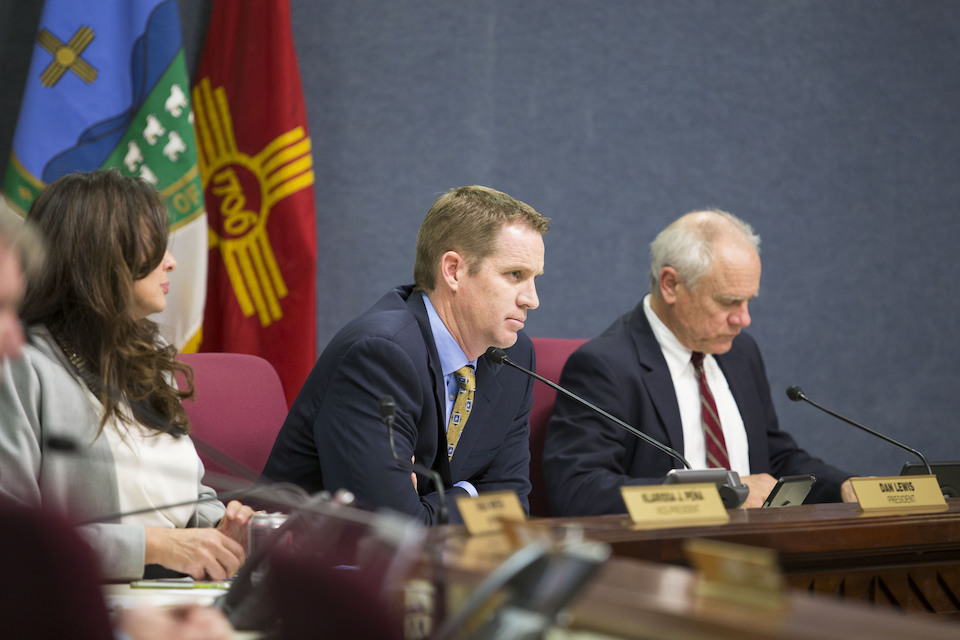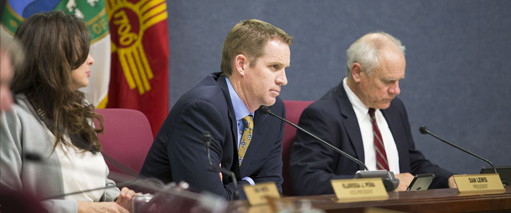Sliding into the Monday, April 4 regular meeting, Albuquerque City Councilors hit a few bumps early on. Shortly into the public comments part of the session, Council President Dan Lewis called a recess and cleared the Council chambers over an upside down flag. Activist Silvio Dell’Angela silently refused to put down the flag. Lewis repeatedly asked Dell’Angela to mind the rules of the meeting which do not allow large signs or banners. Dell’Angela says the upside down flag is a symbol of distress over the city of Albuquerque. After about an hour, Councilors returned but Dell’Angela was not allowed back in the chambers for the remainder of the meeting. Dell’Angela is a regular attendee at the meetings who often speaks out against the police department and city administration. He has been bringing his flag to meetings for a while and was also escorted out of the last Council meeting over his sign of distress.Sued You!A couple of lawsuits were filed Monday to stop the $119 million Albuquerque Rapid Transit Project. One of the lawsuits filed in State District Court names all nine Albuquerque City Councilors along with Mayor Richard Berry, Chief Administrative Officer Rob Perry, Transit Director Bruce Rizzieri, Chief Operations Officer Michael Riordan, the US Department of Transportation and the Federal Transit Administration. John McCall is the attorney representing the group of 7 residents and 10 businesses including the Western Steakhouse on the west Central end of the project.The second lawsuit to halt the project was filed in US District Court by attorneys John Boyd and Yolanda Gallegos. They are representing a different set of plaintiffs who call themselves the Coalition of Concerned Citizens to Make ART Smart. These plaintiffs include the Nob Hill Flying Star owners, Jean and Marc Bernstein, among other businesses along the route.Along with the injunction requests, the lawsuits say the Berry administration and the FTA violated the National Historic Preservation Act and the federal Administrative Act. The lawsuits say the 10-mile long project that stretches along Central from Coors to Louisiana is a public nuisance and will negatively impact more than 48 National Historic Registry historic landmarks along the route. It is alleged that the project will also destroy more than 217 historic and environmentally significant trees. They also accuse the government actors of malfeasance and its actions as arbitrary, capricious and contrary to law. Maria Bautista, the lead plaintiff in the state court lawsuit, spoke at the meeting giving them a heads up that they were being sued. “You did not listen to your constituents,” she said.Rolling!Ann Lerner from the city’s film office gave an update on the economic impact of the city’s film industry. In 2015 the movie business dropped more than $150 million in direct spending in the area for goods and services to make movies. Lerner said tax incentives are the biggest lure for filmmakers along with the climate, the lack of natural disasters, and the way the city can double for a lot of locations. Lerner said the city also has a great overall film environment. She said there are currently five TV shows in production here.Hello? 911?Mayor Berry submitted his fiscal year 2016-2017 budget last week. Tucked into the budget was some startling news regarding the city’s police response times. The budget document claims it takes an average of 11 minutes and 24 seconds for an officer to arrive on the most serious Priority one calls. This is 41 seconds longer than last year and almost two and a half minutes longer than in 2010. The time it takes for a 911 dispatcher to answer an incoming call is longer as well. City officials and administration say this is due to understaffing in the police department. Berry’s budget proposes a $250,000 bump to add more dispatchers to answer calls as well as giving police officers a 1.5 percent raise. Police union representatives say this is a slap in the face and an officer pay raise of about 4.5 percent will keep officers from leaving the department. The police department budget, as usual, takes up the biggest budget bite—about 31 percent of the city’s total budget.No Bucks for Brass?Councilor Diane Gibson introduced a bill proposing the city no longer give Albuquerque Police Department command staff raises until the department is in compliance with the US Department of Justice’s use of force settlement with APD. James Ginger, the independent monitor hired to oversee the federal agreement, has said in his reports that the city’s progress is being slowed down by top officials dragging their feet to make the court mandated policy changes. The bill will go to committee and then will be back at the Council table.Land ListCouncilors approved two separate bills to outline how the city will go about buying land for open space and a list of proposed properties to add to the city’s open space jewel box. The City Council will now be able to weigh in on the purchases. Some of the properties on the list include: Cerro Colorado Volcano, Northern Sand Dunes, East Tijeras Arroyo and several parcels in the Volcano Cliffs area.Next TimeChanges to Angel’s Law, the city’s dangerous dog ordinance, will be heard at the next meeting. Councilor Trudy Jones said there was still some work to do on the changes which would make it easier for the city to seize dogs that have proven themselves dangerous.
Send your comments about the City Council to carolyn@alibi.com.The next meeting Monday, April 18, 5pmCouncil Chambers in the basement of City HallView it on GOV TV 16 or at cabq.gov/govtv






